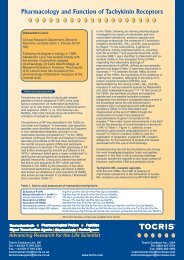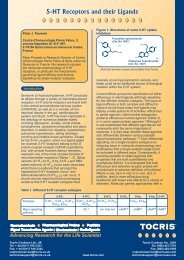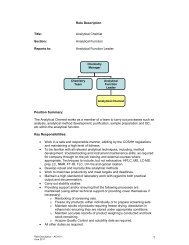Dopamine Receptors - Tocris Bioscience
Dopamine Receptors - Tocris Bioscience
Dopamine Receptors - Tocris Bioscience
You also want an ePaper? Increase the reach of your titles
YUMPU automatically turns print PDFs into web optimized ePapers that Google loves.
<strong>Dopamine</strong> <strong>Receptors</strong>Table 1 | <strong>Dopamine</strong> receptor subtypes defined from physiological, pharmacological, and biochemical studiesPhysiological FunctionsBiochemical ResponsesD 1-like <strong>Receptors</strong>Aspects of motor and cognitive function (brain),cardiovascular functionAdenylyl cyclase↑Phospholipase C↑LocalizationCaudate nucleus, putamen, nucleus accumbens,olfactory tubercle, cerebral cortex, cardiovascularsystemReceptor Antagonists SCH 23390SCH 39166SKF 83566LE 300Receptor Agonists A 77636SKF 38393SKF 81297A 68930SKF 81297DoxanthrineRadioligands [ 3 H]-SCH 23390*[ 125 I]-SCH 23982D 2-like <strong>Receptors</strong>Aspects of motor function and behavior (brain), control of prolactin andα-MSH secretion from pituitary, cardiovascular functionAdenylyl cyclase↓K + channel activity↑Ca 2+ channel activity↓GSK-3b↑Caudate nucleus, putamen, nucleus accumbens, olfactory tubercle,cerebral cortex, anterior and neurointermediate lobes of pituitary gland,cardiovascular systemDomperidoneNemonaprideRaclopride(S)-(-)-SulpiridePHNOQuinpiroleN-0437RotigotineSumanirole[ 3 H]-Nemonapride (YM-09151-2)[ 3 H]-Raclopride[ 3 H]-Spiperone**(Bold text denotes compounds available from <strong>Tocris</strong> at time of publication)The localization data are from functional and ligand-binding studies on dispersed tissues and tissue slices. *[ 3 H]-SCH 23390 can also bind to 5-HT 2receptors if present;**[ 3 H]-Spiperone can also bind to 5-HT 1A, 5-HT 2receptors, and α 1‐adrenoceptors if present.phenothiazines such as fluphenazine also show high affinity butare not selective for D 1-like over D 2-like receptors. The developmentof the first D 1-like receptor agonist, SKF 38393, wasimportant for differentiating between activation of D 1‐like andD 2‐like receptors, although it was later realized that the partialagonist nature of SKF 38393 produced an under-appreciation ofthe contribution of D 1-like receptors to behavior. 26 The D 1‐likereceptors show moderate affinities for typical dopamine agonistssuch as apomorphine; full and/or selective D 1-like receptoragonists such as such as A 77636, A 68930, SKF 81297, dihydrexidine,and doxanthrine are now available (Box 2). Thereare minor differences in the affinities of some compounds forthe D 1and D 5receptors (higher agonist and lower antagonistaffinities for D 5), but no compounds that effectively distinguishbetween those subtypes are as yet available. 27,28D 1receptors are found at high levels in the typical dopaminerichregions of brain such as the neostriatum, substantia nigra,nucleus accumbens, and olfactory tubercle, whereas the distributionof the D 5receptors is much more restricted (Table 2);this subtype is found generally at much lower levels. Bothreceptors are able to stimulate adenylyl cyclase (Figure 1), withthe D 5receptor showing some constitutive activity for thisresponse. 28 Inverse agonist activity at the D 1and D 5receptorsis seen in recombinant systems for some compounds such asbutaclamol, 28 which were previously considered to be antagonists.It has been known for some time that stimulation of aD 1-like receptor leads to activation of phospholipase C 29 andrecently this response has been linked to the D 1/D 2receptorheterodimer, providing a function for heterodimer formation. 30Agonists that preferentially stimulate the cAMP response(SKF 83822) or the phospholipase C response (SKF 83959)associated with D 1-like receptors have been described. 31The D 1receptor seems to mediate important actions ofdopamine to control movement, cognitive function, andcardio vascular function. Direct interactions between D 1‐likereceptors and ion channel-linked receptors have been described(D 1/NMDA, D 5/GABA A), 32 leading to modulation of receptorfunction. These interactions provide for cross talk between fastand slow neurotransmitter systems and may point towards afurther functional role for the D 5receptor, which is not wellunderstood. Studies with null mutant ‘knock-out’ mice havesuggested that in some respects, the functions of the D 1andD 5receptors are reciprocal – for example, with respect tospontaneous locomotion – and in other respects similar, forexample with respect to grooming or psychostimulant-inducedlocomotion. 33,34D 2-like receptorsOverall, the D 2, D 3and D 4receptors exhibit pharmacologicalproperties similar to those of the originally defined D 2receptor;that is, they all show high affinities for drugs such as thebutyrophenones (haloperidol, spiperone) and substitutedbenzamides (sulpiride, raclopride), and these classes of drugsprovide selective antagonists for D 2-like receptors over D 1-likereceptors (Table 3). As indicated above, the D 2‐like receptorsalso show high affinities for phenothiazines and thioxanthines.Each D 2‐like receptor has its own pharmacological signature,so there are some differences in affinities of drugs for the individualD 2‐like receptors (Box 3). For example, sulpiride andraclopride show high affinity for the D 2and D 3receptors butwww.tocris.com | 3







